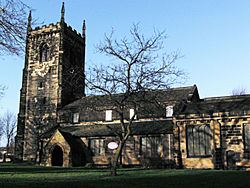All Saints' Church, Normanton facts for kids
Quick facts for kids All Saints' Church |
|
|---|---|
 |
|
| 53°41′52″N 1°24′54″W / 53.6979°N 1.4149°W | |
| OS grid reference | SE 38737 22539 |
| Location | Normanton, West Yorkshire |
| Country | England |
| Denomination | Anglican |
All Saints' Church is a historic church located in Normanton, West Yorkshire, England. It serves as the main church for the local community.
Contents
A Look Back: The History of All Saints' Church
All Saints' Church has a very long and interesting past! People believe the church building you see today has been around since at least 1256. It was likely started by Roger Le Peytevin from Altofts Hall.
Early Beginnings: A Church from the Domesday Book
Even before the current building, a church was mentioned in this spot in the Domesday Book of 1086. This was a huge survey ordered by William the Conqueror to record everything in England! This means there has probably been a church on this very ground for over 900 years.
Knights and Construction: Building the Church
In 1256, Roger Le Peytevin, a powerful Norman lord, gave the church to a group called the Knights Hospitallers. They were a famous order of knights who also ran hospitals.
The church was built in a style called "perpendicular." This means it has tall, narrow windows and strong, straight lines. It was mostly made from carefully cut sandstone blocks and has a stone roof.
Key Parts of the Church Building
The church has a main area called the nave where people sit. On either side are aisles. At the front is the chancel, which is where the altar is. A tall tower was added to the western end of the church in the 1400s. Later, in the 1800s, rooms for the clergy (church leaders) and choir were added, along with a special room for the organ.
In 1965, the building was given a special Grade II* listing. This means it's a very important historic building. The inside of the church has been updated a few times, most recently in 2019.
Treasures and Memorials: What's Inside the Church?
All Saints' Church is home to many interesting items and memorials that tell stories of the past.
The Freeston Tomb and Its Legacy
One important monument is the Freeston Tomb. This is the burial place of Sir John Freeston (who passed away in 1594). He was a very generous person. In his will, he arranged for an almshouse (a place for poor people to live) in Kirkthorpe. He also set up a grammar school for children in Normanton and Warmfield. His kindness still helps today, as his gift provides funding for the Freeston Business and Enterprise College, a secondary school in Normanton.
Ancient Altar and Font
In 1906, a medieval altar slab was discovered under the floor. This stone slab has five crosses carved into it. It had probably been hidden since the Reformation (a time of big changes in the church). Now, it stands in the Lady Chapel and is used for weekly services.
The church also has an old, eight-sided stone font. This is where baptisms take place. It is now located at the west end of the main church area.
Windows That Tell Stories
The window at the east end of the Lady Chapel shows the fall of the Walls of Jericho. This beautiful window is a memorial to the soldiers who lost their lives in the Great War.
Another window, located to the left of the porch, was added in the late 1970s. It is a memorial to the famous explorer, Martin Frobisher, who came from nearby Altofts.
Historic Silver Cups
All Saints' Church owns two very old silver cups. These are now kept safely in a collection at York Minster. The oldest cup was made in London in 1655 and has "Normanton cupp 1674" written on it. The second cup is a two-handled porringer (a type of bowl). It says, "The Gift of Mrs Henry Favell of Pontefract to the Church of Normanton for ever 1699."
Family Memorials and Benefactions
The church also contains many memorial slabs and tombs for important local families like the Favells, Mallets, and Levetts. These families lived in Normanton for centuries. One tablet mentions that "Mrs. Elizabeth Levett made benefaction for the poor of Normanton and Snydale, and for teaching poor children." This shows how people in the past helped their communities.
There are also several memorials to James Torre, a historian from Yorkshire. He gave up his law career to focus on historical research.
Church Leaders: A List of Incumbents
Above the door to the old clergy vestry (a room for the clergy) on the north wall of the chancel, there is an oak board. This board has a list of all the church leaders, called incumbents, dating back to Henry of Kyrkeby in 1252.
See also
- List of places of worship in the City of Wakefield
- Grade II* listed buildings in West Yorkshire
- Listed buildings in Normanton, West Yorkshire

